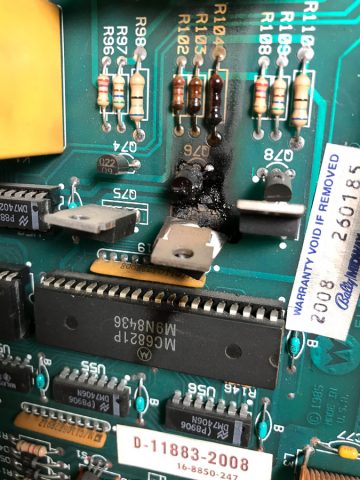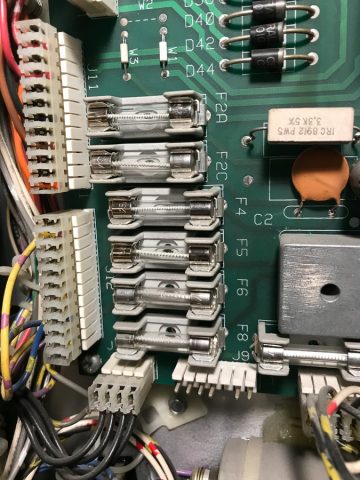Symptom: Machine is not working at all
Location: Greenwood Village, Colorado
The first problem the machine had were the batteries had been forgotten about. So the battery holder was replaced and new batteries were installed. All too common a problem.
While replacing the batteries, I noticed some burned circuitry.
The burned driver circuitry was related to the lower pop bumper. Whenever I see this kind of damage, I always check the fuses. Sure enough someone installed a 7 amp fuse where it should only be a 2 amp fuse.
Out of the 6 fuses shown above, 3 were incorrect values, all higher than what they should have been.
The fuses are meant to protect against this kind of damage. Often in the history of a pinball machine, someone will replace a fuse with a higher rated fuse to keep it from blowing again without every investigating why the fuse blew in the first place. I’m not really sure why people do this. So instead of just simply having a blown transistor, the circuit board got damage and the pre-driver transistor, 7402 chip, and the coil were all damaged and had to be replaced. The 7 amp fuse never blew to protect the circuits. Instead the transistor caught fire and burned until it acted as its own fuse and the circuit eventually opened.
The actual cause was the switch contacts on the pop bumper being adjusted too close together. Causing the pop bumper to energize continuously.
This wasn’t my customer’s fault. The blame probably goes to the operator who first purchased the pinball machine and placed in a public location to make money. A fuse or two probably blew and to keep the machine making money, installed larger fuses. Then eventually the pinball machine ends up in a home environment with the wrong fuses installed.


